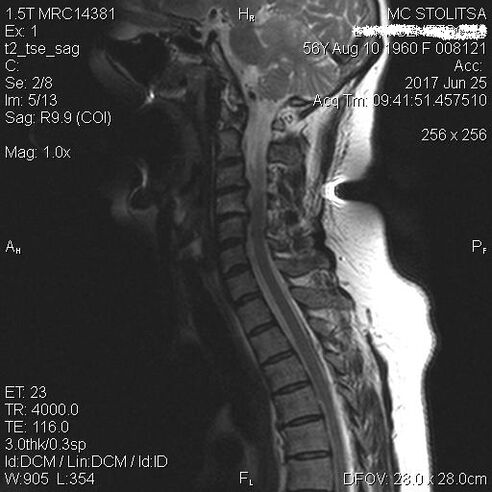Cervical osteochondrosis is a pathological change in the intervertebral disc tissue and the vertebral itself.As a result, the soft tissue becomes thinner and the impact of vertebrae depreciation is reduced.The blood vessels and nerve fibers are squeezed, and the mobility of the cervical spine is reduced.
Cervical osteochondrosis is the most dangerous local area and local area for osteochondrosis, because the disease causes deterioration in the blood supply to the brain.
More dangerous than cervical osteochondrosis
As a result, the normal function of the cervical spine is impaired, its mobility is reduced, and neck pain occurs.Cervical osteochondrosis can lead to worsening of blood circulation in the brain, migraine, heart rhythm disorder, visual disorder, coordination and attention, and the development of vertebral hernia.
Osteochondrosis and spinal disease in the cervical vertebrae
Symptoms of cervical osteochondrosis
The disease is characterized by acute pain in the neck, nape of the neck, shoulder blade and forearm.The pain can be exacerbated when the head moves or when some posture moves.The cervical muscles are overwhelmed due to the pain and inflammation process.The patient is often observed in migraines, with sharp changes in hearing and vision, dizziness, tinnitus, blood pressure, and fainting conditions.Symptoms of osteochondrosis in the cervical area may violate the sensitivity of the fingertips.
Causes of cervical bone and chondropathy
The causes of cervical osteocartilage degeneration are often associated with tissue aging and age-related tissue changes.However, lifestyle and related factors increase the risk of disease development.These include:
- Low physical exercise and long-term sitting work;
- Too much weight and improper nutrition;
- Diseases of the musculoskeletal system: flat feet, rheumatism, scoliosis, posture diseases;
- Injury to the neck or back.
In addition, osteochondrosis may be caused by other spinal diseases.The spine is a whole and needs to be processed in a complex.This is why the first thing you need to do when you suspect osteochondrosis is to have a comprehensive examination of the spine.
Treatment of cervical bone and chondropathy
Prescribe after examination.Doctors collect a type of blood removal and guide the patient to perform examinations.Most are often in magnetic resonance tomography.After discovering the exact cause of the disease, they begin treatment.
In acute periods, doctors prescribe painkillers and anti-inflammatory drugs.During the remission period - physical therapy procedures - massage, shockwave therapy, physical therapy exercises.These methods are designed to strengthen muscle corsets, relieve tension and prevent disease attacks.
Prevent cervical osteochondral disease
- Pass regular exams.The disease is easier to warn of than cure.Annual examinations will reveal the disease early and cure the disease until it becomes a more serious phase.
- Follow the posture.Keep your back and shoulders relaxed.If you work a lot on a computer or desk, choose a comfortable chair, sit correctly, and warm up every half hour or an hour.
- Live an active lifestyle.Walk more, go to the fresh air, play sports, and swim are particularly useful.
- During sleep, use orthopedic pillows.



















